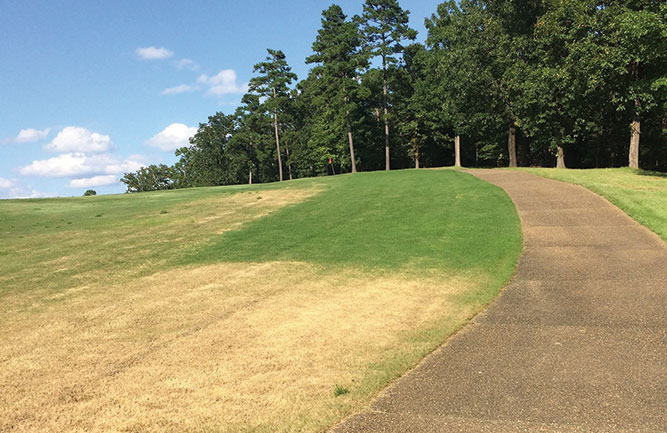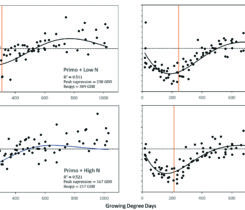Turf Pest: Fighting grubs, fall armyworms in the Texas Hill Country

Vaaler Creek Golf Club has lost a lot of turf due to fall armyworm infestations. (Photo: Vaaler Creek GC)
About halfway between Austin and San Antonio, Vaaler Creek Golf Club’s 100 acres of maintained turf is surrounded by live oaks, scrub grasses and other foliage native to the Texas Hill Country. That natural beauty can make Todd Leist’s job a big pain in the neck.
“We’re out in the country, so we have a lot of native grasses and trees where the armyworms can lay their eggs on the native plants,” says Leist, superintendent of Vaaler Creek inside the Rockin J Ranch in Blanco, Texas. “All of the sudden, we get infestation moving in from those natives. By the time you’ve had a chance to get it sprayed out, you can lose a lot of turf.”
To control regular grub outbreaks and fall armyworm infestations, Leist treats the course twice a year, wall to wall, with chlorantraniliprole. A heavy spring application followed by a lighter fall application keeps grubs and armyworms under control, he says.
“At first, I was doing 8 ounces per acre of the liquid, wall to wall, and then a booster of 4 ounces in the fall around October. I still wasn’t getting quite the control I needed on the grub side, so I boosted that to 12 ounces per acre in the spring, around early April, and then a booster of 6 ounces of liquid in the fall, around late September early October. I’ve had a lot better results,” Leist says.
For the past two years, he says he’s used granular pesticides — 300 pounds per acre in the spring, 150 pounds per acre in the fall — so he can apply fertilizer and chlorantraniliprole at the same time.
For courses that can afford it, Leist says wall-to-wall coverage with chlorantraniliprole offers superintendents peace of mind because it provides such long-term pest control. However, courses that don’t have the grub and armyworm pressure from native foliage that he has may not be able to justify that cost.
“The wall-to-wall option isn’t viable for everyone,” Leist explains. “You can do a buffer around the property. We did that at my previous course … We would do a two-boom spray rig around the property, and that would catch grubs and armyworms before they got into the property.”
Bug-controlling freeze
In most years, Leist credits chlorantraniliprole for the lack of grubs, armyworms and bugs on his course, but this year, the massive February storm that dropped snow and freezing temperatures across the state seems to have killed off a lot of insects and larvae.
“Normally, in my shop area, the wash bay lights stay on 24/7, and they’d just be covered in bugs,” Leist says. “This year, I could have counted on my hands how many bugs we saw.”
The hard freeze allowed him to delay his spring pesticide application until
May because Leist says he wasn’t seeing the pest activity he usually expects in April. On the other hand, the freeze killed off about 1,500 square feet of turf on his No. 4 green.
“It’s a very undulated green and has north-facing slopes. Unfortunately, the snow that we had was a very dry snow. When the snow fell, it was so dry that a lot of it blew off of the north-facing slopes, especially on that green, so that’s where we got a lot of winterkill,” Leist says, adding that he doesn’t have an on-site nursery and the sod farms in Texas lost much of their turf to the weather, so he’s had to sacrifice portions of his practice putting green to fill in damaged turf.












